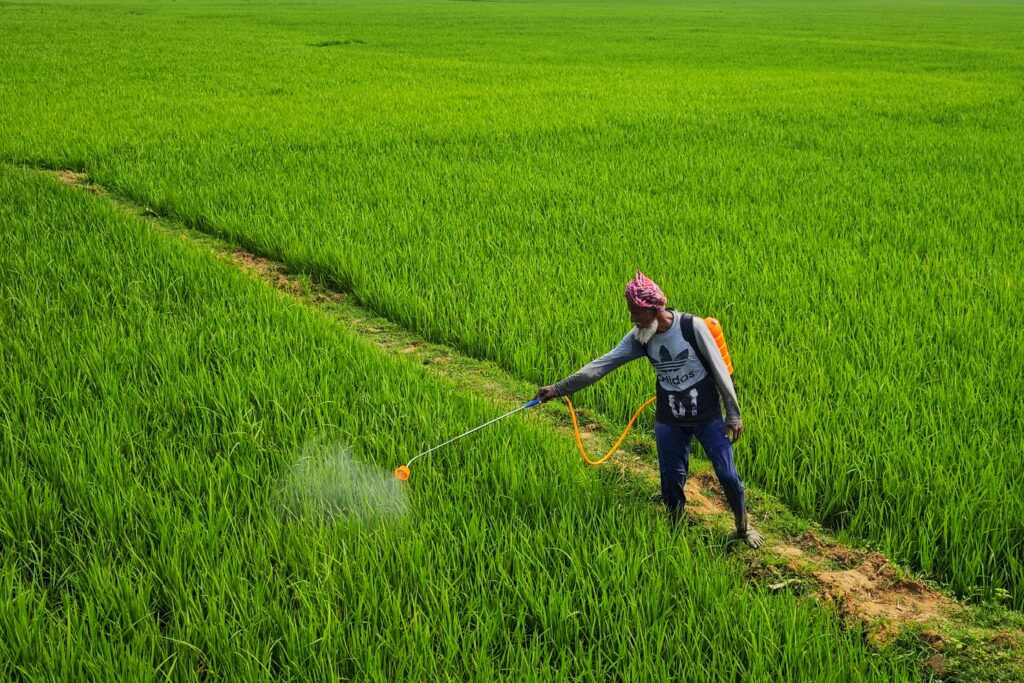In this blog post Effective Tips for Spraying Weed Killer 2024, Not only is applying weed killer a task on your gardening list, but it’s also a necessary routine that maintains the health of your garden. When done correctly, it keeps weeds from overwhelming your garden’s valuable plants and blooms, promoting plant growth. Your garden will look lovely and your lawn will remain healthy if you make sure that the unwanted invaders are the only ones taken out. This process requires precision, knowledge, and a small amount of caution.

Three Types of Weeds: Sedge, Grassy, and Broadleaf
To begin weed control, you must identify your objective. There are three categories of weeds: grassy, sedge, and broadleaf.
As the plant emerges, broadleaf weeds often develop two seed leaves and have branching stems and larger leaves. Some broadleaf weeds are:
Read also Best Time For Grass Seed? & Tips for Successful Seeding
- White clover
- Dandelion
- Thistle
- Pokeweed Erect ivy
Like ordinary turfgrass, grassy weeds only produce one seed leaf. Grassy weeds include, for example:
Sedges, Goosegrass, Crabgrass, Rushes, and Sedges all have a single seed leaf, but when examined in cross-section, the leaves have a triangle form, as seen in:
Nutsedge in yellow color.
Weeds, Both Annual and Perennial
Because annual weeds only survive for one season, controlling them is simpler.
Perennial weeds grow again every year from the same root system, such as crabgrass or dandelions.
An annual weed has already done the majority of its damage and will eventually die, according to horticulture agent Mary Helen Ferguson of the Louisiana State University Extension in Livingston Parish. A seed that has germinated will remain in the soil for the ensuing years.

Recognize Your Weeds
Determine which weeds need to be removed before you go to the store to get weed killer. For additional assistance in identifying weeds, the following resources can be useful:
The non-profit Weed Science Society of America (WSSA) works to further knowledge about weeds and how they affect the environment. They also provide a gallery of cannabis images to assist homeowners in identifying the offender.
You can also get help identifying your weeds from your local County Extension Service.
Formulations for Herbicides: Granular, Liquid, Selective, and Nonselective
You have more options now that you are aware of your cannabis kind. Which herbicide type do you like to use—liquid or granular? Is it nonselective or selective? Ferguson states, “The best kind of product will depend on the kind of weed you’re trying to kill and the type of turfgrass that you have.”
Based on the bullet points below, choose the one that will work best for you:
- With a handheld or backpack pump sprayer, liquid herbicides are typically combined with water and sprayed.
- Granular herbicides are applied using a fertilizer spreader after being combined with an inert carrier like clay, lime, or fertilized soil.
- Certain plants are killed by selective herbicides. If the label reads “broadleaf herbicide” or anything like that, it is selective.
Two Spraying Methods: Spot and Broadcast
Knowing whether to employ a spot or broadcast spray strategy for yard spraying depends on the area to be treated and the type of vegetation (landscaping and plants) in it. Keep them separate to avoid damaging your yard.
Using a broadcast sprayer allows you to treat the whole lawn with herbicide. The grass can withstand selective weed killer, so you can spray it widely.

Spot treatments administer the herbicide directly to the weed, sparing other plants from harm, using an applicator similar to a pressurized sprayer. Easy to use on sidewalks and in the vicinity of patios.
After learning about the distinctions between the main types of herbicides, check out our list of the top weed killers available to discover which one is ideal for you.
When to Apply Herbicides
Advanced Herbicides
Apply pre-emergent herbicides prior to the emergence of summer and winter annual weeds. The secret is understanding when to use pre-emergents:
Summer annuals: These weeds are spring-blooming, summer-loving, seed-bearing, and winter-dead. Before the soil temperature reaches 52 degrees Fahrenheit, apply pre-emergent herbicide to manage troublesome summer annuals such as goosegrass, foxtail, and crabgrass.
Winter annual weeds: Fall- or winter-born weeds such as poa annua and filaree sprout in the spring and die when summer temperatures rise. Apply a pre-emergent whenever the soil temperature reaches 70 degrees Fahrenheit to prevent these weeds from growing above the earth’s surface.
Replicated Herbicides
Don’t worry if you put off applying a pre-emergent because you put it off. You can use both nonselective and selective herbicides whenever you locate plants that are actively growing. But early in the growing season, when the weeds are still little, is when these post-emergents perform best.
For the most effective management, apply in the spring (late April–early June) or early fall (September 15–October 15). (The time varies according to your location.)
Apply a thin layer of weed spray on the leaves. Avoid applying a lot of post-emergent herbicides to a certain region. After washing past the plants, it will enter the soil and have the potential to harm nearby plants or water supplies.

Reapply if necessary. It may take many applications spaced ten to twenty days apart to completely remove stubborn weeds.
The best defense against weeds is to continue practicing good lawn care practices.
Grow it out: Your grass will get stressed and more susceptible to weeds if you mow it too short. Observe the rule of one-third: Cut no more than one-third of the height of the grass blades at a time.
Give it up: lawn cuttings can act as a mulch that feeds the lawn. Instead of bagging your grass clippings, leave them on the lawn to keep weeds out.
Read also Top 6 Grass Types For Louisiana: Guide To Ideal Lawns
Give up the thatch: The layer of decomposing and living organic matter that accumulates between your grass and topsoil is called thatch. If the thatch on your grass is more than half an inch thick, it might draw pests and illnesses. To get to the layer beneath the grass, dredge the tines of a dethatching rake, also known as a power rake, deep into the grass.
Give it enough water: Watering deeply and infrequently encourages a strong, resilient root system. If the majority of your soil is clay, irrigate it once a week with about an inch of water. Lower this quantity to 0.5 inches of water twice a week if your land is more sandy. It is preferable to water the lawn before 10 a.m. Avoid watering your yard after dark.
Have it examined: If you desire a weed-free lawn, a soil test could mean the difference between success and failure. For instance, dandelion thrives in low-calcium, low-pH, acidic soils with high potassium content.
Feed the beast: Your grass requires nutrients to grow and prosper. Fertiliser is the greatest way to increase nutrition. See how to choose the best fertilizer for your grass.
Conclusion
Transforming your garden into a lush sanctuary involves more than routine care; it requires the thoughtful and precise application of weed killer. This sacred practice is essential for maintaining a healthy lawn. By identifying and targeting different types of weeds—sedge, grassy, and broadleaf—you can prevent them from overshadowing your valuable plants and blooms.
Effective weed control involves understanding the life cycle of annual and perennial weeds, allowing you to choose the right herbicide. Pre-emergent herbicides prevent weed seeds from germinating, while post-emergent herbicides tackle actively growing weeds. Selecting the appropriate formulation—granular, liquid, selective, or nonselective—enhances your ability to manage weeds effectively.

Using proper spraying methods, such as spot or broadcast spraying, ensures that only unwanted weeds are eliminated, preserving the health of your garden. Complementing weed control with good lawn care practices—proper mowing, mulching, dethatching, deep watering, and soil testing—creates a robust defense against future weed invasions.
